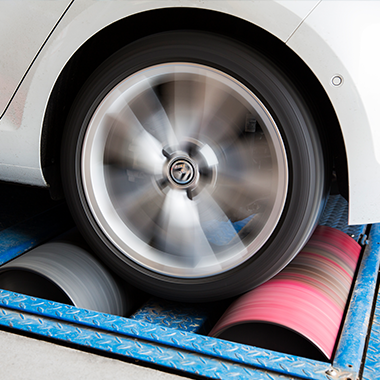- Home
- Services
- Vehicle tuning
- Car dyno testing
Car dyno testing

Measuring torque and engine power values is not only useful for tuning cars. These parameters provide valuable insights into the condition of the engine. Testing your car on a dyno can reveal power loss, reduced cylinder compression, or resistance caused by other components. Additionally, measuring power and torque helps check if these values are evenly developed. High performance isn't the only factor; the way power and torque are delivered at different engine speeds matters too. Checking the engine's performance on a dyno also allows evaluating how well it runs on LPG. This is essential as improperly tuned LPG installations could damage the engine.
Dyno testing for cars can be divided into chassis dyno and engine dyno. Chassis dynos, equipped with special rollers, can be further categorized as load-bearing or inertial dynos. Chassis dynos are not as precise as engine dynos, but they don't require engine removal, making them more commonly used. But what sets a load-bearing dyno apart from an inertial dyno? Both measure power at the wheels, but they generate resistance in different ways. An inertial dyno uses a standard flywheel with high inertia, while a load-bearing dyno creates resistance through an electric eddy current brake. This allows the dyno to control the load and simulate road conditions.
Tips
The accuracy of dyno measurements depends not only on the type of dyno but also on various factors. Each dyno manufacturer specifies necessary conditions for accurate power measurements, such as air temperature and atmospheric pressure. Even under-inflated or worn-out tires can affect readings from the measuring equipment and sensors.
It's important to note that chassis dyno measurements don't directly concern engine parameters but rather indicate how much power and torque are transmitted to the wheels.
To avoid overheating the engine during testing, almost every dyno is equipped with a cooling fan.
Load-bearing dynos allow simulating various conditions, making power and torque measurement with the brake more reliable, closer to real-world driving conditions on the road or track.
Dyno testing is suitable for both single and all-wheel-drive vehicles.
The measurement process for one car usually takes about 20 minutes.
The power and torque curves provide information about many malfunctions, such as issues with the turbocharger, airflow meter, fuel injection system, fuel pump, variable valve timing system, or EGR valve. An irregular power development line indicates abnormalities.
It's recommended to visit a dyno after installing an LPG system. An incorrectly tuned gas installation could result in running on an excessively lean fuel-air mixture and, consequently, burning valve seats
Engine dynos offer more precise power measurements but are mainly used by car manufacturers and a few tuning studios.
A dyno allows determining both the power of the engine and the resistances generated by the gearbox, driveshaft, bearings, or CV joints. The measurement process involves accelerating the wheels to a certain speed and then disengaging the clutch. This makes power tests more accurate and enables the determination of real power.
During tests, many other parameters are measured, such as boost pressure, exhaust gas temperature, air-fuel mixture composition, or turbocharger speed.
Dynos with a load can perform measurements in steady-state mode, inertial mode, load mode, and road mode.
The quality of the equipment significantly influences the measurement results, and each element of the dyno should be properly calibrated. Dynos from Dynoproject are highly popular, offering high measurement accuracy for 4x4 vehicles.
The cost of the service ranges from approximately $150 to $400, depending on the type of drivetrain.
Scope of services
Measuring engine torque and power
Testing parameters in 4x4 vehicles
Measuring engine efficiency replicating road conditions
Checking exhaust emissions
Engine diagnostics and tuning
Engine chip tuning and program map modifications
Mechanical engine tuning
Boost pressure control
Find a car workshop
Check out our workshops that offer the service car dyno testing in some of the biggest cities in your country
Additional info about the service
How does a car dyno work? The operation of the most popular dynos is not complicated. The tested car is placed on special rollers that generate braking force. The car remains stationary and is securely fastened with durable straps for safety. Ventilators ensure an adequate supply of oxygen to the engine, while exhaust gases are directed through a tube connected to the exhaust pipe. Power and torque tests are conducted using either an inertial method, utilizing the inertia of the rollers, or by using eddy current brakes. The brakes generate braking force, allowing the testing of cars with power output nearing 1000 HP. Some dynos are equipped with two sets of rollers, enabling testing of 4x4 vehicles.
Digital microprocessor sensors continuously analyze data, creating power and torque curves. The measurement accuracy can be as precise as 0.1 HP, ensuring repeatability of test results and the ability to detect even the smallest changes in the engine's performance characteristics. Thanks to the use of eddy current brakes, the control system can differentiate braking force, simulating conditions such as wind resistance or driving uphill.